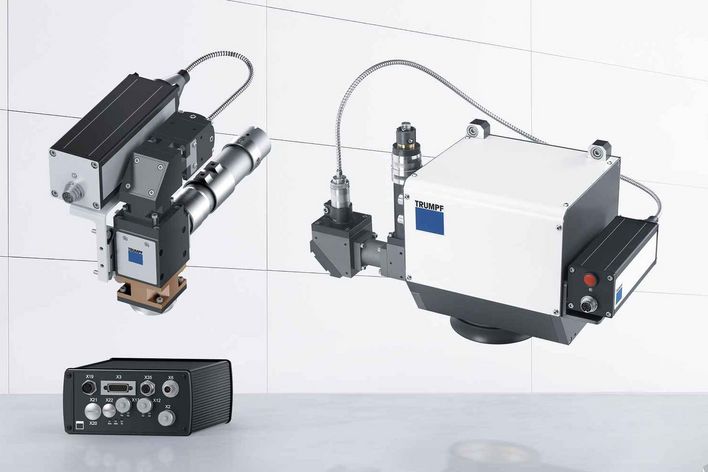Always the right temperature
The TRUMPF temperature control registers the intensity of the thermal radiation on the component surface and controls the laser power based on the set nominal temperature. When used in laser plastic welding and laser case hardening, it ensures consistent results – even when working with complex component geometries. When used with a scanner, the temperature controller is integrated directly into the electronics of the PFO. The pyrometer also sits directly on the optics – external units are not necessary. There is a compact control box included in the scope of delivery with the fixed optics.
The adjustable nominal temperature and limit value parameters mean that you achieve optimum quality.
Direct coupling of the pyrometer to the optics and parameterization using TruControl.
Guaranteed traceability due to stored temperature data.
You can use the trend indicator to detect slow divergence of the process at an early stage.

Laser plastic welding using the quasi-simultaneous method
With the TRUMPF temperature control you can weld plastic housings or plugs of electronic control units, sensors, and actuators with high-quality welding and a tight seal. Impurities or higher glass fiber content in the laser-transparent upper part are quickly detected due to their deviating temperature behavior.

Laser plastic welding using the contour method
In contour welding, the component is rotated under the fixed laser beam. The temperature control ensures a consistently high heat input across the entire seam point.

Laser case hardening
The temperature control for laser case hardening regulates the laser power in a spatially resolved manner. This enables a build-up of heat on the edges, holes, or corners of components to be avoided.
|
Temperature control for plastic welding
|
Temperature control for laser case hardening
|
|
|---|---|---|
| Configuration | ||
| Available lasers | TruDiode 151, TruDiode 301, others on request | TruDisk up to 6 kW |
| Available focal lengths |
200 / 250 mm (BEO D50)
200 / 280 mm , others upon request (PFO 20-2 post-objective) |
560 mm , others upon request (PFO 20-2 post-objective) |
| Available focal lengths of collimation |
35 mm (BEO D50)
34.5 / 56 / 80 mm (PFO 20-2 post-objective) |
80 mm (PFO 20-2 post-objective) |
| Parameters | ||
| Pyrometer measurement range | 180 °C - 520 °C (with emission factor ε = 1) | 650 °C - 1600 °C |
| Pyrometer measurement rate | 2 kHz (500 µs) | 4 kHz (250 µs) |
| Temperature control cycle rate | 12.5 kHz (80 µs) | 12.5 kHz (80 µs) |
| Typical precision | 3 % at 250°C (providing there is an annual calibration) | 2 % at 1000°C (providing there is an annual calibration) |
The technical data of all product versions as a download.

Temperature control for laser plastic welding
The TRUMPF temperature control for laser transmission welding of plastics measures the temperature of the joining zone with a pyrometer. The system registers the intensity of the thermal radiation in a pre-determined wavelength spectrum and regulates the laser power
to the nominal temperature. Typical applications are the quasi-simultaneous welding of closed contours with scanner optics and the contour welding of round parts with fixed optics.

Temperature control for laser case hardening
In the case of laser case hardening, the pyrometer measures the
surface temperature during the hardening process and
regulates the laser power in a spatially resolved manner. This makes it possible to avoid a build-up of heat
on the edges, holes, and corners of the components and
to achieve a uniform hardness depth at a defined degree of hardness. By
using the scanner optics, you can harden all manner of
geometries. And with the oscillating laser beam,
you can even produce varying track widths.
This product range and information may vary depending on the country. Subject to changes to technology, equipment, price, and range of accessories. Please get in touch with your local contact person to find out whether the product is available in your country.






